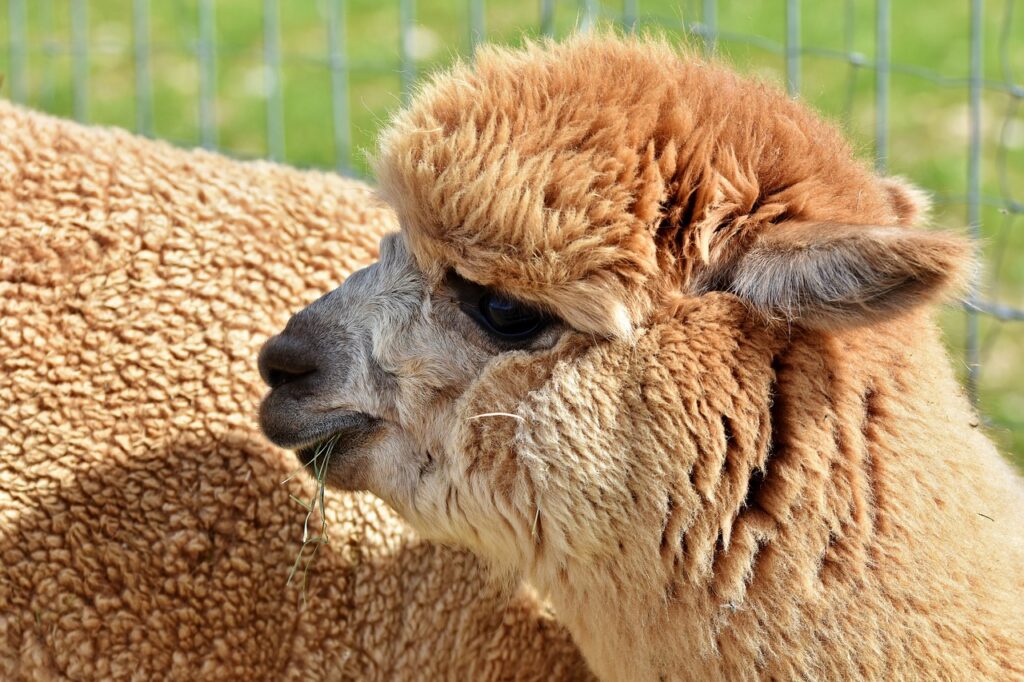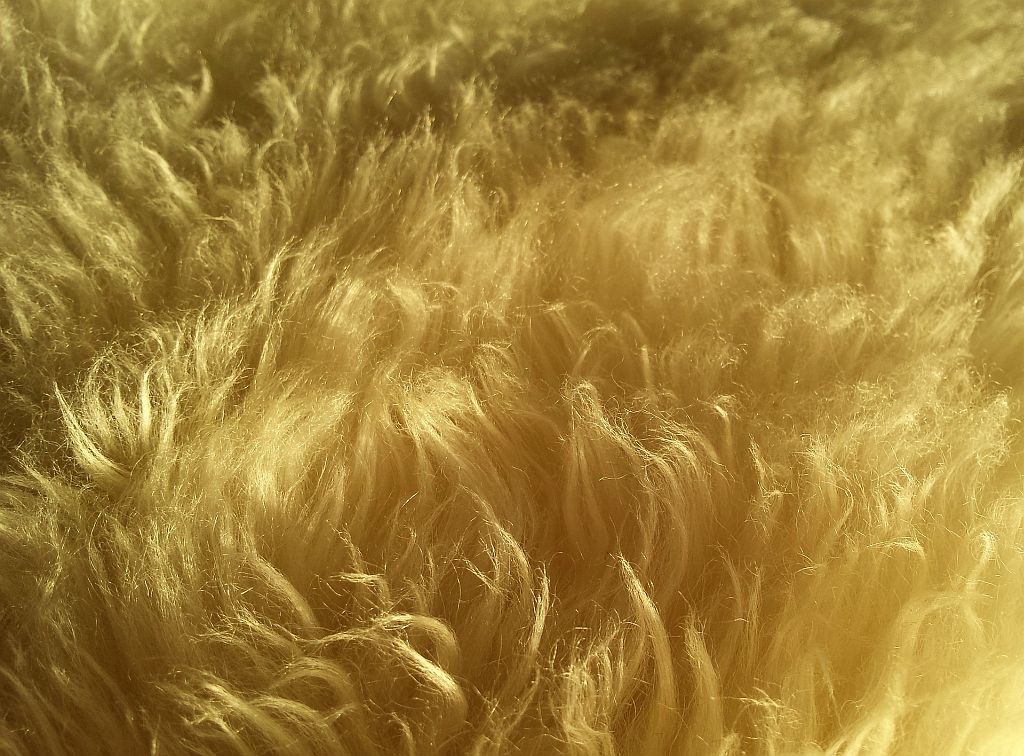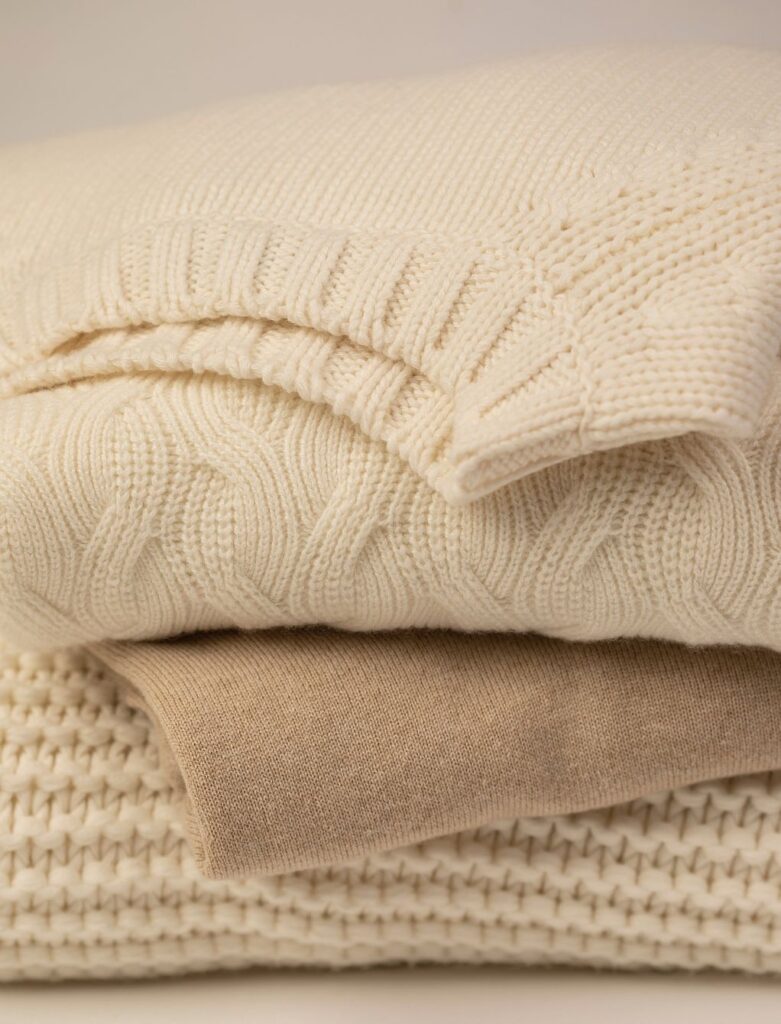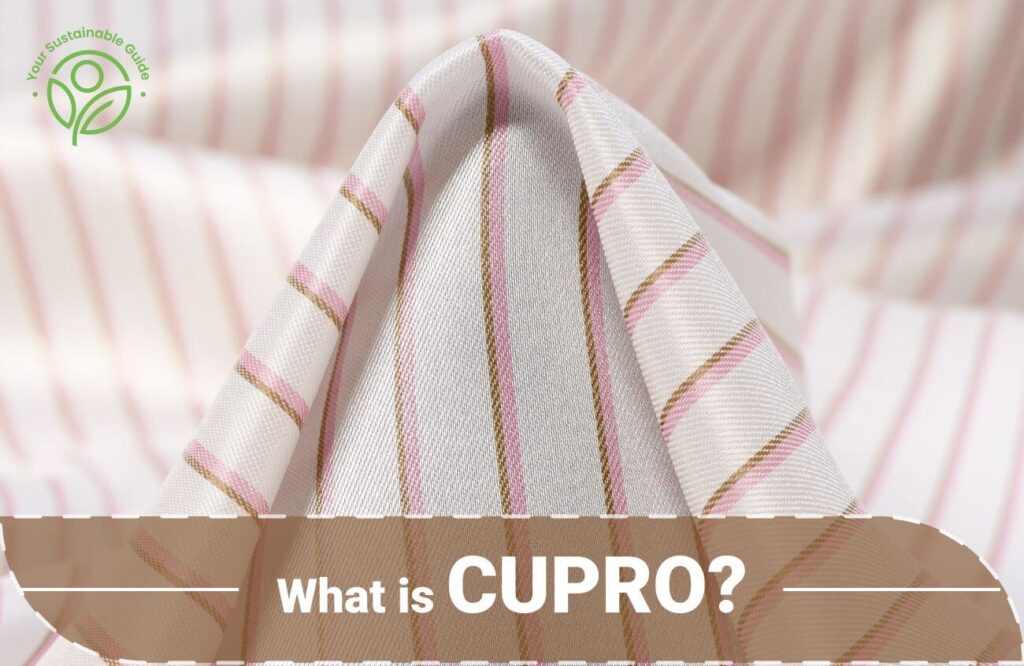Owning an alpaca wool shawl or sweater will give you a true appreciation for why they are so beloved and considered a classic. But it may even be so that you’ve never heard of alpaca fleece before or what in the world alpacas are in the first place. But fear not! Because we’re here to help. In our journey to uncover the most sustainable fabrics, both natural and man-made, today’s feature will be all about alpaca wool. So grab your cup of coffee and sit back for an insightful read.
OMG! These cutesy-featured alpacas are a vision in themselves and the alpaca fleece feels as luxurious as any organic textile can ever be. Native to South American countries, alpacas are known as camelids because of their striking resemblance to camels and fall under the category of species members like llama, vicuña, and guanaco. Alpaca wool is the hairlike fiber sheared from these animals and used in crafting sweaters, shawls, gloves, and other winter wardrobe staples.
But that brings us to the question, whether alpaca wool is sustainable or not. Also, the cruelty that goes behind wool shearing isn’t unknown to mindful shoppers, and alpaca wool is just another form of animal product. Well, read on to find out if it is cruelty-free too.
- What is Alpaca Wool?
- Is Alpaca Wool Sustainable?
- Is Alpaca Wool Affordable?
- Is Alpaca Wool Ethical?
- Is Alpaca Wool Cruelty-Free?
- Alpaca Wool Certifications
- Properties of Alpaca Wool
- Pros & Cons of Alpaca Wool
- Uses of Alpaca Wool
- How to Care for Alpaca Wool Fabric
- Famous Brands That Use Alpaca Wool
- Best Alternatives to Alpaca Wool
- Conclusion
What is Alpaca Wool?
Alpaca wool is the yarn made from fiber-like fluffy hair that grows naturally on alpacas. This wool is extremely soft, water and snow-resistant, lustrous, lightweight, and comes in 22 natural colors. Considered five times warmer and stronger than sheep wool, alpaca fleece contains microscopic air pockets giving it a high thermal capacity. Owing to all the qualities of an exotic natural fleece, alpaca wool is highly desired by consumers and falls under the category of the finest yarns. It is viewed similarly to rare and exclusive fibers like cashmere and mohair for its luxurious feel.

The alpaca history dates back thousands of years when the vicuna (alpacas’ ancestors) were tamed and bred by the indigenous people of the Andean highlands of Peru, Chile, and Bolivia. Alpacas came into existence after selective breeding of the vicuna and soon these animals became an integral part of the Inca tribes, not only for their fur but also for their meat. The alpaca fleece used to be reserved for the ‘royalty’ because of its numerous beneficial qualities, and was even revered as “the fiber of the gods.”

With time as this fleece gained popularity because of its luxe quality and low impact on the environment, these animals are now being bred in herds by alpaca breeders in New Zealand, Australia, and North America as well. Whereas, Peru remains to be the leading producer and exporter of alpaca wool with 90% of shipments.
Mainly two breeds of the alpaca are used for textile purposes: the Huacaya alpaca and the Suri alpaca. Both these breeds have different qualities and textures of hair and are equally prized. The Huacaya alpaca fibers have a short and springy texture with a natural crimp, making it of stretchable quality. Whereas, the Suri Alpaca have silky, shiny long hair tangled up in a dreadlock-like fashion. Huacaya alpaca makes up a majority of 95% of the alpaca population.
How is Alpaca Wool Harvested?
Alpaca wool production begins with the shearing of the alpacas, whose fuzzy hair fibers have reached a certain proportion and are ready to be harvested. While the shearing period might vary as it totally depends on the hair growth and the regions where the alpacas are raised, ideally these animals are shorn before the beginning of warmer months.
Shearing methods are basically of two types: Hand shearing and Electric shearing. Hand shears are similar to scissors and take a long time to complete the procedure on one alpaca. Electric shears, on the other hand, is the widely used method because it can be completed in a matter of minutes. Generally, 2-3 people are involved in the shearing process as the alpacas are highly resistant to this activity. Shearers usually go close to the skin when shearing alpacas, which results in the entire coat coming off as one large mat.
Next, the freshly harvested raw wool is carded (combed in a uniform direction to separate the hair strands) and is ready to be spun into yarn. The spinning into yarn also involves two methods: 1) The traditional method used by the indigenous people of Peru and 2) The spinning by advanced technologies done in factory settings. The spinning process is then followed by washing the wool to remove dirt and other impurities.
In Peru, indigenous people make non-toxic and simple washing substances from wild plants for cleaning the wool. However, in other countries, the wool may be cleaned before weaving or knitting by other non-toxic cleaning agents. Finally, the wool is air-dried and is ready to be used in textile products.
Is Alpaca Wool Sustainable?
Yes, alpaca wool is sustainable for the environment as the breeding of alpacas and the harvesting of these animals’ wool has a low environmental impact. Since a majority of the alpaca population is bred in their native environment, the Andean highlands, so no extra facilities are required for high-quality fiber growth.
Alpacas’ mild grazing does not damage or destroy root systems, so the land remains undamaged, and plants continue to grow even after an alpaca has eaten the top portion. Plus, Alpacas’ water and food intake are less compared to sheep and goats. In addition, these animals have padded feet that are gentle on the soil surface and do not harm the earth.
As alpaca fleece is naturally free from lanolin or oil, it is easy to wash without using solid detergents or chemicals. Alpaca waste can also be used as a potent fertilizer.
Is Alpaca Wool Affordable?
Alpaca wool is expensive because of its limited availability and high quality. While fleece from younger alpacas tends to be pricier because of its softness and lightness, older alpaca fleece can be a bit cheaper because of its thickness. Alpaca wool comes in different colors and the price also varies depending on the most desirable colors. For example, a pure alpaca woolen scarf can be priced somewhere around $60 to $245 depending on the length.
Again, alpaca wool that comes from Peru is expensive because of the ethical indigenous people and methods involved like old-school shoring methods, fair trade practices, fair wages, and most important, sustainable farming of the alpacas.
Is Alpaca Wool Ethical?
Yes, alpaca wool is ethical. Alpacas are animals whose fuzzy hair needs to be sheared from time to time allowing them to live a healthy and comfortable life. Although it very much depends on the breeders, processes, and the timespan in which alpaca wool is extracted.
Alpaca breeders in South America are mostly indigenous people. These breeders are really enthusiastic about farming and harvesting alpaca wool since it has been their core livelihood for centuries. They are really compassionate about their furry friends and the wool is harvested in traditional environment-friendly methods. Imagine the shearing to be just like getting a yearly ‘haircut’, which if not done, creates more discomfort for the alpacas.

Alpaca hair is shorn once a year at most, as their fleece needs time to grow to an ideal length and quality. Many ethical breeders even shear the fuzzy fiber once in one and a half years. The alpaca wool shearing takes place during the spring or early summer season, in order to let the animals live comfortably during the warmer months. The shearing process is often done ethically in gentle traditional methods making sure the animal isn’t hurt.
Is Alpaca Wool Cruelty-Free?
Alpaca wool is not only cruelty-free but really sustainable for the environment. As we’ve already mentioned, alpaca fleece needs to be sheared to avoid health issues as these animals do not shed their fleece naturally. The shearing process does get stressful for the animals as it is not a natural experience for them, because of the loud noise of the equipment involved and the restraining of the animals, but when done with utmost care and caution, the shearing is more of a relief to the alpacas.
While most alpaca wool is cruelty-free, there are a lot of commercial breeders, who do not follow the responsible harvesting criteria. Many times the alpacas are shorn more than once a year and the workers usually slam them inhumanely on the floor, hit, kick and harshly shear through their coat resulting in cuts and wounds which are often left untreated by these breeders. Often tied to a restraining device, alpacas also are killed in the torturous shearing practices.
As a result of the harm that alpacas endure in many farms, PETA has already declared alpaca wool to be cruel. In light of the investigation, many famous brands have already banned the use of alpaca wool.
Alpaca Wool Certifications
Farmers/Breeders producing alpaca fibers, manufacturers producing textile products using alpaca fiber, distributors, and brands dealing in alpaca products can be certified by
- Responsible Alpaca Standard (RAS)
- World Fair Trade Organization (WFTO)
- United States Department of Agriculture (USDA)
Properties of Alpaca Wool

- Alpaca wool is entirely biodegradable and eco-friendly.
- It is lightweight, very soft, and luxurious to the touch compared to other types of traditional wool.
- Alpaca wool has a low water retention rate making it water-repellant.
- The airiness of the alpaca fiber traps and retains heat making it highly insulative without becoming too heavy.
- It is non-inflammable.
- It is hypoallergenic as the alpaca wool naturally lacks oils and lanolin.
- It doesn’t have the prickly nature of wool, hence it is more comfortable.
- Alpaca wool has tiny air pockets that provide enhanced breathability.
- The Huacaya wool is of elastic nature, making it perfect for knitting. Whereas, the Suri alpaca wool is more suited for weaving because of its silky long strands of fiber.
Pros & Cons of Alpaca Wool
Pros of Alpaca Wool:
- Alpaca fleece is 30% stronger and warmer than wool extracted from most sheep.
- Unlike traditional wool, alpaca fleece is soft and hypoallergenic, making it suitable for all skin types.
- Alpaca wool is stronger and lighter than other wool.
- It is 100% biodegradable.
- It absorbs colors quite well and can be dyed easily.
Cons of Alpaca Wool:
- Alpaca wool is expensive.
- Alpaca wool, once dyed doesn’t remain fully biodegradable.
- It is sensitive to moths.
- Animal-friendly practices are not guaranteed.
- Alpaca wool is not vegan.
Uses of Alpaca Wool

- Known for its even insulation, the incredibly versatile alpaca wool is used in weaving a range of winter garments that include cardigans, coats, sweaters, shawls, even shirts, and all sorts of outerwear.
- Home furnishing items like alpaca wool mattress toppers, bedsheets, blankets, duvets, mats, throws, etc. are also made from alpaca wool.
- Accessories that can be knitted with alpaca yarn are gloves, scarves, mittens, and socks, among others.
How to Care for Alpaca Wool Fabric
- Clothes made of alpaca wool should never be machine-washed. They must be hand-washed at all times. Just soaking your alpaca clothing in a mix of water and gentle wool-friendly soap is all that’s required.
- Once the item has soaked, agitate it a little and rinse it while being careful not to let it expand.
- Do not wring as this may result in the garment losing its shape. Instead, gently squeeze out excess water.
- Dry the garment by placing it n a flat position. Reshape it once dried.
- Always iron alpaca garments in a wool setting.
Famous Brands That Use Alpaca Wool
While a lot of brands are incorporating alpaca fleece in their collection, these brands are our favorite for housing an amazing range of alpaca products.
- Peruvian Connection
- Eileen Fisher
- Arlette Lee
- Plum of London
- AYNI
- Carolina K
- Purl Alpaca Designs
- Maydi
Best Alternatives to Alpaca Wool
Merino Wool – Merino wool is another luxurious category of wool derived from the merino sheep. Considered to be sustainable this wool is super-soft, lightweight, and breathable, and helps regulate body temperature, making it perfect for not only winter wear but also summer outdoor wear. Merino wool has the amazing quality of transporting sweat quickly leaving you odorless and dry at all times. Plus, it is completely biodegradable and fire-resistant.
Cashmere – Cashmere is a kind of soft wool which is renowned for its silky-smooth texture and is derived from cashmere goats or pashmina goats. Prized as the most luxurious of all wools, cashmere wool is basically the soft undercoat of these particular goats and has high insulation qualities and is extremely lightweight because of which it is often blended with other fibers to get an added weight.
Mohair – Mohair is derived from the fleece of angora goats and is somewhat a mixture of the goat’s topcoat and undercoat. Quite lustrous with a certain sheen, mohair is durable, resilient, has some elasticity, and blends well with other fibers. In addition, it has moisture-wicking abilities, is heat resistant, and has good insulating abilities.
Woocoa – Woocoa is a vegan wool developed by a group of design students from the Universidad de Los Andes in Bogotá, Colombia. This biofabricated material is made from hemp and coconut fibers and treated with oyster mushroom enzymes in a controlled environment. Woocoa is a soft, high-quality textile that is breathable in summer and keeps you cozy in winter. It has also won the PETA Prize for Animal-Free Wool in the 2018 Biodesign Challenge.
Conclusion
Fibers that are sourced from animals do go through exploitation when more and more brands come forward to incorporate them in their products. Although we love alpaca wool for its sustainable footprint, exotic feel, and prime source of income for the Andean indigenous people, it can’t be denied that a portion of the alpaca wool industry has indeed taken the dark path to profit.
So the next time you go shopping for alpaca wool products, make sure to check for sustainable brands working with certified alpaca breeders so that you invest in the right sort of alpaca fleece that doesn’t have an innocent animal’s blood on it.







